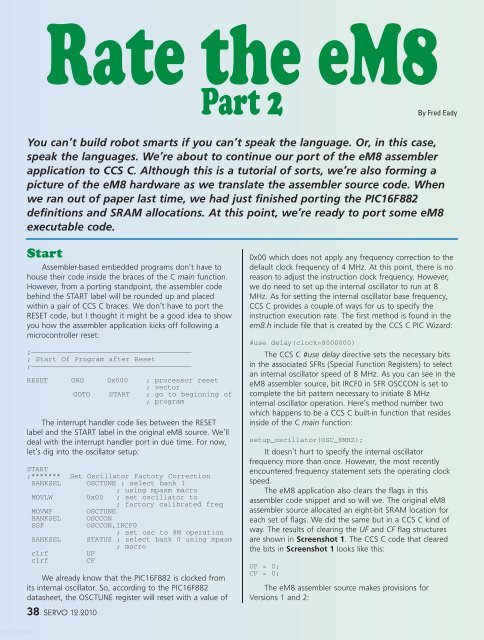You also want an ePaper? Increase the reach of your titles
YUMPU automatically turns print PDFs into web optimized ePapers that Google loves.
worldmags<br />
worldmags<br />
Rate the eM8<br />
Part 2 By Fred Eady<br />
You can’t build robot smarts if you can’t speak the language. Or, in this case,<br />
speak the languages. We’re about to continue our port of the eM8 assembler<br />
application to CCS C. Although this is a tutorial of sorts, we’re also forming a<br />
picture of the eM8 hardware as we translate the assembler source code. When<br />
we ran out of paper last time, we had just finished porting the PIC16F882<br />
definitions <strong>and</strong> SRAM allocations. At this point, we’re ready to port some eM8<br />
executable code.<br />
Start<br />
Assembler-based embedded programs don’t have to<br />
house their code inside the braces of the C main function.<br />
However, from a porting st<strong>and</strong>point, the assembler code<br />
behind the START label will be rounded up <strong>and</strong> placed<br />
within a pair of CCS C braces. We don’t have to port the<br />
RESET code, but I thought it might be a good idea to show<br />
you how the assembler application kicks off following a<br />
microcontroller reset:<br />
;——————————————————————————————————————<br />
; Start Of Program after Reset<br />
;——————————————————————————————————————<br />
RESET ORG 0x000 ; processor reset<br />
; vector<br />
GOTO START ; go to beginning of<br />
; program<br />
The interrupt h<strong>and</strong>ler code lies between the RESET<br />
label <strong>and</strong> the START label in the original eM8 source. We’ll<br />
deal with the interrupt h<strong>and</strong>ler port in due time. For now,<br />
let’s dig into the oscillator setup:<br />
START<br />
;******* Set Oscillator Factoty Correction<br />
BANKSEL OSCTUNE ; select bank 1<br />
; using mpasm macro<br />
MOVLW 0x00 ; set oscillator to<br />
; factory calibrated freq<br />
MOVWF OSCTUNE<br />
BANKSEL OSCCON<br />
BSF OSCCON,IRCF0<br />
; set osc to 8M operation<br />
BANKSEL STATUS ; select bank 0 using mpasm<br />
; macro<br />
clrf UF<br />
clrf CF<br />
We already know that the PIC16F882 is clocked from<br />
its internal oscillator. So, according to the PIC16F882<br />
datasheet, the OSCTUNE register will reset with a value of<br />
38 SERVO 12.2010<br />
0x00 which does not apply any frequency correction to the<br />
default clock frequency of 4 MHz. At this point, there is no<br />
reason to adjust the instruction clock frequency. However,<br />
we do need to set up the internal oscillator to run at 8<br />
MHz. As for setting the internal oscillator base frequency,<br />
CCS C provides a couple of ways for us to specify the<br />
instruction execution rate. The first method is found in the<br />
em8.h include file that is created by the CCS C PIC Wizard:<br />
#use delay(clock=8000000)<br />
The CCS C #use delay directive sets the necessary bits<br />
in the associated SFRs (Special Function Registers) to select<br />
an internal oscillator speed of 8 MHz. As you can see in the<br />
eM8 assembler source, bit IRCF0 in SFR OSCCON is set to<br />
complete the bit pattern necessary to initiate 8 MHz<br />
internal oscillator operation. Here’s method number two<br />
which happens to be a CCS C built-in function that resides<br />
inside of the C main function:<br />
setup_oscillator(OSC_8MHZ);<br />
It doesn’t hurt to specify the internal oscillator<br />
frequency more than once. However, the most recently<br />
encountered frequency statement sets the operating clock<br />
speed.<br />
The eM8 application also clears the flags in this<br />
assembler code snippet <strong>and</strong> so will we. The original eM8<br />
assembler source allocated an eight-bit SRAM location for<br />
each set of flags. We did the same but in a CCS C kind of<br />
way. The results of clearing the UF <strong>and</strong> CF flag structures<br />
are shown in Screenshot 1. The CCS C code that cleared<br />
the bits in Screenshot 1 looks like this:<br />
UF = 0;<br />
CF = 0;<br />
The eM8 assembler source makes provisions for<br />
Versions 1 <strong>and</strong> 2:




